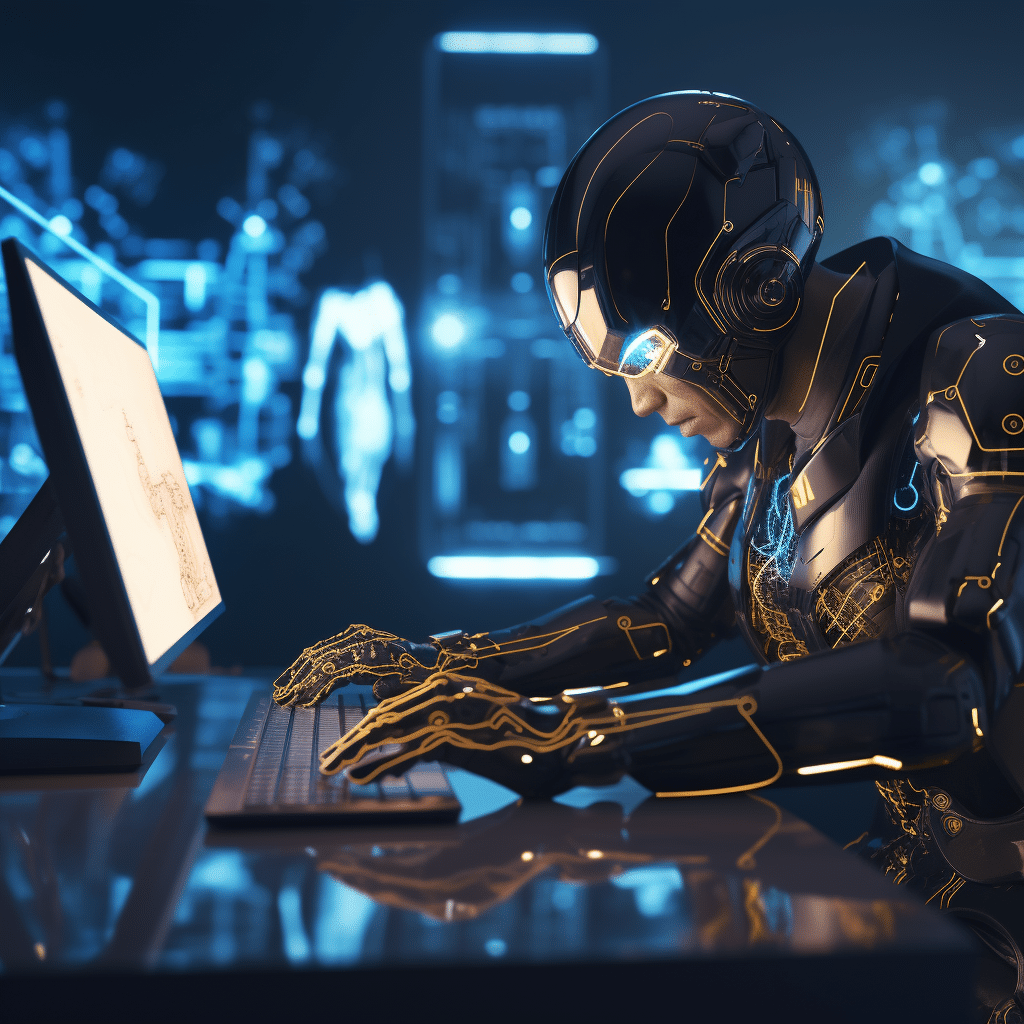
AI in Cybersecurity: Strengthening Digital Defenses
AI in cybersecurity, The rapid advancements in technology have brought numerous benefits to our lives, but they have also given rise to new threats and vulnerabilities, particularly in the realm of digital security. Cyberattacks are becoming more sophisticated, making it crucial for organizations and individuals to fortify their digital defenses. With this challenge in mind, artificial intelligence (AI) is emerging as a powerful tool in cybersecurity, empowering defenders to detect, prevent, and remediate cyber threats.
How does AI enhance cybersecurity?

An AI-based cybersecurity system employs machine learning algorithms to analyze vast amounts of data and identify patterns that could signal a potential cyber threat. The system can autonomously learn from these patterns and continuously improve its ability to detect and prevent attacks.
-
- Advanced Threat Detection: AI systems can analyze data from various sources such as network traffic, user behavior, and system logs to detect anomalies and identify potential threats in real-time. These systems can also distinguish between legitimate activities and malicious actions with remarkable accuracy.
- Automated Response: Once a threat is detected, AI-powered systems can respond swiftly and autonomously, taking immediate action to mitigate the risks. This means that cyber threats can be addressed promptly, reducing the potential damage caused.
- Smart Authentication: AI capabilities can strengthen authentication methods by analyzing multiple factors such as biometrics, device information, and behavioral patterns to identify authorized users accurately. This reduces the risk of unauthorized access to sensitive information and systems.
The future of AI in cybersecurity
AI in the cybersecurity landscape is still relatively nascent, but its potential is immense. As AI technology continues to evolve and improve, we can expect even more advanced cybersecurity solutions. Here are some potential future developments:
-
- Adaptive Defense: AI systems will develop the ability to adapt to evolving threats and detect new attack vectors, making them more resilient to ever-changing cyber risks.
- Preventing Insider Threats: AI algorithms can analyze user behavior and identify deviations that indicate potential insider threats. This can help organizations proactively address internal vulnerabilities.
- Enhanced Analysis and Decision Making: AI’s machine learning capabilities can enable faster and more accurate analysis of security events, enabling quicker decision-making during cyber incidents.
- Collaboration with Humans: AI and human cybersecurity experts can work together synergistically, with AI systems assisting humans in decision-making and augmenting their capabilities.
As AI continues to mature, it will play an indispensable role in safeguarding our digital environments against ever-evolving cyber threats. By harnessing the power of AI, we can strengthen our defenses and ensure a safer and more secure future in the digital realm.
What are the key challenges in implementing AI solutions for cybersecurity, and how can they be overcome?
Implementing AI solutions for cybersecurity faces several key challenges:
1. Lack of quality training data:
AI models require large amounts of high-quality data for training. However, in cybersecurity, obtaining labeled data is challenging due to the sensitive nature of the data and the constantly evolving nature of cyber threats. Overcoming this challenge involves collecting diverse and relevant datasets, leveraging data augmentation techniques, and anonymizing or synthesizing data when necessary.
2. Adversarial attacks:
Adversaries can attempt to exploit vulnerabilities in AI models to launch attacks. Adversarial attacks involve injecting malicious inputs to deceive or manipulate the AI system and bypass security measures. Mitigating this challenge requires developing robust and resilient AI models through techniques such as adversarial training, model diversity, and anomaly detection.
3. Explainability and transparency:
AI models often lack transparency, making it difficult to understand how decisions are made. In cybersecurity, explainability is crucial for understanding and validating the decision-making process of AI systems. Overcoming this challenge involves the development of explainable AI techniques, such as rule extraction, model auditing, and interpretable machine learning.
4. False positives and false negatives:
AI systems may generate false positives (flagging benign activities as malicious) or false negatives (missing actual malicious activities). Reducing false positives and negatives involves continuously refining and fine-tuning AI models by incorporating feedback from cybersecurity experts and considering contextual information beyond raw data.
5. Scalability and resource constraints:
Implementing AI solutions in large-scale cybersecurity environments with limited resources can be challenging. Training and deploying AI models require substantial computational resources and expertise. Addressing this challenge involves optimizing model architectures, leveraging cloud computing infrastructure, and collaborating with industry experts to overcome resource constraints.
6. Ethical and legal considerations:
AI systems for cybersecurity raise ethical and legal concerns, such as privacy infringement and discriminatory biases. Overcoming these challenges requires adhering to ethical principles during development, conducting thorough impact assessments, ensuring regulatory compliance, and involving multidisciplinary teams, including legal and ethical experts.
To overcome these challenges effectively, it is crucial to foster collaboration between cybersecurity professionals, AI researchers, and policymakers. Constant research and development efforts, ongoing learning from real-world deployments, and a proactive approach to addressing emerging threats are essential to harness the potential of AI for cybersecurity.
In what ways does AI in cybersecurity contribute to strengthening organizations’ digital defenses against cyber threats?
AI in cybersecurity contributes to strengthening organizations’ digital defenses against cyber threats in various ways:
1. Threat detection and prevention:
AI-powered algorithms can continuously monitor and analyze large volumes of data to identify malicious patterns and anomalies that may indicate cyber threats. This enables proactive detection of potential attacks before they cause any harm.
2. Real-time incident response:
AI systems can automatically respond to cyber threats in real-time, analyzing and taking appropriate actions to mitigate the impact of an attack. This reduces the response time and minimizes the damage caused by the threat.
3. Advanced malware detection:
AI algorithms can detect and analyze complex malware and advanced persistent threats that traditional signature-based detection systems may miss. This can help in identifying new and emerging threats that have not been previously seen.
4. User and entity behavior analytics (UEBA):
AI can analyze user behavior patterns and identify any anomalies that may indicate potential insider threats or compromised user credentials. This helps in detecting and preventing unauthorized access to systems and data.
5. Automating security operations:
AI can automate routine security tasks, such as log analysis, vulnerability scanning, and patch management. This frees up human resources to focus on more complex security challenges and enables faster response to potential threats.
6. Enhanced threat intelligence:
AI can analyze large volumes of cybersecurity data from multiple sources, including external threat feeds, to provide organizations with up-to-date and actionable threat intelligence. This helps in understanding the threat landscape and proactively preparing against potential attacks.
7. Predictive analytics:
AI algorithms can analyze historical data and patterns to predict future cyber threats and vulnerabilities. This allows organizations to take proactive measures to strengthen their defenses before an attack occurs.
Overall, AI in cybersecurity helps organizations stay one step ahead of cyber threats by automating and augmenting human capabilities, enhancing threat detection, response speed, and intelligence, and reducing the impact of cyberattacks.
What are the potential risks and ethical considerations associated with the integration of AI into cybersecurity practices

There are several potential risks and ethical considerations associated with the integration of AI into cybersecurity practices. These include:
1. Bias and discrimination:
AI algorithms can be influenced by biased or incomplete data, leading to discriminatory outcomes. If the AI model is trained on data that is biased against certain groups, it may result in unfair treatment or exclusion.
2. Privacy concerns:
AI systems can collect and analyze large amounts of data, raising concerns about the privacy of individuals. If not properly protected, this data can be misused or stolen, leading to privacy breaches.
3. Lack of transparency:
AI models can be highly complex and difficult to interpret, making it challenging to understand how they make decisions. This lack of transparency raises concerns about accountability and the ability to identify and rectify any errors or biases.
4. Adversarial attacks:
AI systems can be susceptible to adversarial attacks where malicious actors manipulate or deceive AI models. This can lead to AI systems making incorrect decisions or being vulnerable to exploitation.
5. Overreliance and human dependency:
Relying solely on AI systems for cybersecurity can create a false sense of security. It is crucial to recognize that human experts are still needed to oversee and interpret the outputs of AI systems.
6. Unemployment and job displacement:
The integration of AI into cybersecurity practices may lead to job displacement as certain tasks become automated. This raises concerns about the impact on the workforce and the need for retraining and reskilling of employees.
7. Lack of accountability:
AI systems can operate autonomously, making it difficult to assign responsibility in case of errors or negative outcomes. This lack of accountability raises concerns about the potential for AI systems to operate outside of ethical boundaries.
To address these risks and ethical considerations, it is important to ensure transparency and interpretability of AI algorithms, regularly audit and monitor their performance, prioritize privacy protection, and involve human experts in decision-making processes. Organizations and policymakers must also establish guidelines and regulations to promote responsible and ethical use of AI in cybersecurity practices.









Your article helped me a lot, is there any more related content? Thanks!
Thanks for sharing. I read many of your blog posts, cool, your blog is very good.
Thank you for your sharing. I am worried that I lack creative ideas. It is your article that makes me full of hope. Thank you. But, I have a question, can you help me?
Your point of view caught my eye and was very interesting. Thanks. I have a question for you.
hey there and thank you for your information – I have definitely picked up something
new from right here. I did however expertise some technical issues using this
website, since I experienced to reload the site lots of times previous to I
could get it to load correctly. I had been wondering if your hosting is OK?
Not that I am complaining, but sluggish loading instances times will often affect your placement in google and can damage your high quality score
if advertising and marketing with Adwords. Anyway I’m adding this RSS to
my e-mail and could look out for much more of your respective
exciting content. Ensure that you update this again very soon..
Escape room lista
I was looking through some of your blog posts on this site and I believe this
site is rattling instructive! Retain putting up..